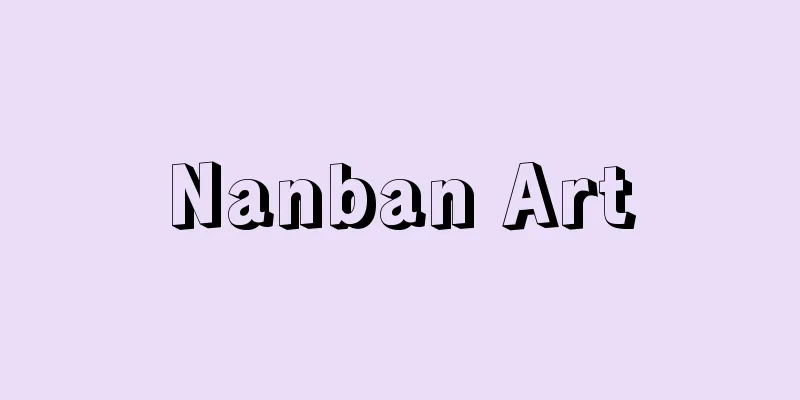Nanban Art

|
A general term for Western-style art that was popular from the Momoyama period to the early Edo period. At the time, Westerners such as Portuguese and Spanish arrived in Japan via their colonies in Southeast Asia, and so they were called "Nanbanjin," meaning foreigners from the south. The exotic paintings and crafts inspired and influenced by the Western culture and customs brought by these Nanbanjin are generally called "Nanban Art." Its heyday was from the late 16th century to the early 17th century, when Christianity was at its peak and Nanban customs were all the rage, but it went into rapid decline due to the policy of banning Christianity and isolating the country during the Kan'ei period (1624-1644). Since Francis Xavier brought a picture of the Virgin Mary with him when he came to Japan in 1549 (Tenbun 18), many religious paintings were created by missionaries who came to Japan to spread Christianity. As Christianity spread, the demand for religious paintings increased rapidly, and it became impossible to rely solely on imported Western paintings. In 1583 (Tensho 11), Giovanni Nicolao came to Japan as a professor of Western painting techniques, and the training of Japanese painters was promoted at the seminary (residence hall) inside the church. At the seminary, various authentic Western painting techniques such as oil painting, fresco, tempera, and copperplate printing were taught, but looking at the works that remain today, many are painted with Japanese native paints on paper. Remaining religious paintings created by Japanese painters include "The Fifteen Mysteries of Mary" (Kyoto University and private collection), "Statue of the Three Saints" (Tokyo National Museum), and "Statue of Francis Xavier" (Kobe City Museum). Western-style painting, which began as a religious painting method for the purpose of spreading Christianity, eventually spread to non-religious paintings for aesthetic purposes. Many of these were painted on shoheiga (folding screens), a traditional Japanese decorative painting style, and included large-scale works with Western themes, such as the series of "Screen paintings depicting the arrival of Southern Barbarians" (commonly known as "Nanban screens"), "Western Kings and Princes on Horseback" (Kobe City Museum and Suntory Museum of Art, Tokyo), "The Battle of Lepanto: World Map" (Kosetsu Museum of Art, Hyogo), and "Westerners Playing Music" (Eisei Bunko, Tokyo and MOA Museum of Art, Shizuoka). Smaller works by Nobukata (years of birth and death unknown), who was the exception among Western painters of this period in that he wrote and stamped his name on the painting, include "Woman Playing the Lyre" (Yamato Bunkakan, Nara) and "Portrait of a Nikkyo Saint" (Shorenji Temple, Hyogo). Thus, early Western-style painting in Japan flourished with the introduction of Christianity, but production came to a halt due to the ban on Christianity in the early Edo period, and it ceased to have much of an impact on the central art world. In the field of crafts, the popularity of Nanban tastes prompted the creation of lacquerware, pottery, metalwork, and other items with Western-style designs. In particular, a group of exotic-style works called "Nanban lacquer art" emerged in lacquer art, and in addition to Christian-related utensils, there remain fresh examples that use Western-style patterns such as Nanban customs and grape arabesques as decorative designs. Representative examples include the "Grape Makie Seihei Box" (Tokeiji Temple, Kamakura) and the "Western Makie Saddle" (Tokyo National Museum). Many export items were also produced to suit the tastes and uses of Westerners, and examples such as the "Autumn Grass Makie Jewelry Box" (Tokyo National Museum) are well known. In ceramics, Oribe ware was known for its use of Western objects and patterns in its paintings, producing unique works such as the Nanban candlestick. Furthermore, the influence of Nanban tastes can also be seen in metalwork, such as the Hoan tsuba (sword tsuba) with Roman letters cut through or inlaid, and the Western-style bell "Nanban Bell" (Shunkoin Temple, Kyoto) with a Christian coat of arms and the year 1577 engraved on it. [Tadashi Kobayashi] "Japanese Art 19: Nanban Art" by Okamoto Yoshitomo (1965, Heibonsha) " "Primary Color Japanese Art 25: Nanban Art and Western-style Painting" by Sakamoto Mitsuru, Sugase Tadashi, and Naruse Fujio (1970, Shogakukan) " "Japanese Art 34: Nanban Art" by Sakamoto Mitsuru and Muramoto Yu (1974, Shogakukan) Source: Shogakukan Encyclopedia Nipponica About Encyclopedia Nipponica Information | Legend |
|
桃山時代から江戸時代初頭にかけて流行した西洋風美術の総称。当時ポルトガル人やスペイン人らの西洋人は、東南アジアにもつ植民地を経由して日本に来航したため、南方の外国人という意味で「南蛮人」とよばれた。これら南蛮人によってもたらされた西洋の文物や風俗に触発・影響されてできた異国的な絵画や工芸品を、一般に「南蛮美術」とよんでいる。その最盛期は、キリスト教の教勢が頂点に達し南蛮風俗が流行した16世紀末から17世紀初頭に求められ、寛永(かんえい)年間(1624~44)に整えられた禁教と鎖国の政策に阻まれて、急速な退潮を迎えるに至る。 1549年(天文18)フランシスコ・ザビエルが来日のおりに聖母マリアの画像をもたらして以来、布教のために来日した宣教師たちによって多くの宗教画が将来された。やがてキリスト教の流布とともに宗教画の需要は急増していき、輸入洋画だけに頼ることが不可能になったため、83年(天正11)西洋画法の教授としてジョバンニ・ニコラオGiovanni Nicolaoが来日、教会内のセミナリオ(修学寮)において日本人画家の育成が進められた。セミナリオでは油絵、フレスコ、テンペラ、銅版画などの本格的な西洋画の諸技術が伝授されたが、現在残る作品をみると、紙に日本在来の絵の具で描かれたものが多い。日本人画家の制作になる宗教画の遺品としては、『マリア十五玄義図』(京都大学および個人蔵)、『三聖者像』(東京国立博物館)、『フランシスコ・ザビエル像』(神戸市立博物館)などが知られている。 こうした布教の手段としての宗教画制作に始まった洋風画は、やがて鑑賞本位の非宗教画にも筆を染めるようになる。その多くは日本の伝統的な装飾画形式である障屏画(しょうへいが)に描かれ、一連の「南蛮人渡来図屏風(びょうぶ)」(通称「南蛮屏風」)をはじめ『泰西王侯騎馬図』(神戸市立博物館および東京・サントリー美術館)、『レパント沖戦闘・万国図』(兵庫・香雪美術館)、『洋人奏楽図』(東京・永青文庫および静岡・MOA美術館)などの西欧的な題材を扱った大作がある。小品としては、この時期の洋画家のうちで例外的にその名を画面に記し印を押す信方(のぶかた)(生没年不詳)の作『婦女弾琴図』(奈良・大和(やまと)文華館)、『日教聖人像』(兵庫・青蓮寺)が名高い。このように、キリスト教の伝来とともに開花した日本の初期洋画であったが、江戸初期のキリスト教禁制によって制作を停止され、中央画壇にほとんど影響を及ぼすことなく、中絶してしまう。 工芸の分野では、南蛮趣味の流行に促されて、西洋風な意匠による漆器、陶器、金工品などがつくられた。ことに漆芸においては、「南蛮漆芸」とよばれる異国的な作風をもつ一群が現れ、キリスト教関係の器具のほか、南蛮人の風俗や葡萄唐草(ぶどうからくさ)などの洋風文様を装飾意匠として用いた新鮮な作例が遺存している。「葡萄蒔絵聖餅箱(まきえせいへいばこ)」(鎌倉・東慶寺)や「洋人蒔絵鞍(くら)」(東京国立博物館)などがその代表例である。また、西洋人の趣味と用途にあわせた輸出品も多く制作され、「秋草蒔絵宝石箱」(東京国立博物館)などの例が知られている。陶芸では、織部焼(おりべやき)が西洋の事物や文様を好んで絵付(えつけ)に用い、南蛮人燭台(しょくだい)ほか異色の作品を生んでいる。さらに、ローマ字を透かしたり象眼(ぞうがん)したりした刀の鐔(つば)(法安(ほうあん)鐔)、キリスト教の紋章と1577の西暦が陽刻された西洋風の鐘「南蛮鐘」(京都・春光院)など、金工方面にも南蛮趣味の反映が認められる。 [小林 忠] 『岡本良知著『日本の美術 19 南蛮美術』(1965・平凡社)』▽『坂本満・菅瀬正・成瀬不二雄著『原色日本の美術 25 南蛮美術と洋風画』(1970・小学館)』▽『坂本満・村元雄著『日本の美術 34 南蛮美術』(1974・小学館)』 出典 小学館 日本大百科全書(ニッポニカ)日本大百科全書(ニッポニカ)について 情報 | 凡例 |
>>: Nanban chickweed - Nanban chickweed
Recommend
Onbu - Onbu
…The word pampa originally means “plain” in Quech...
Pungtungia herzi - Pungtungia herzi
A freshwater fish of the family Cyprinidae in the ...
Anhima carnuta (English spelling)
...It is found from southern Brazil to northern A...
Cardiopulmonary resuscitation (CPR)
This is a procedure to restore cardiac and pulmona...
Codariocalyx motorius
… D . paniculatum (L.) DC. is native to North Ame...
Ramses II
…the third king of the 19th Dynasty of ancient Eg...
Spanish literature
This refers to literature written in Castilian/Sp...
Short bill spearfish
...It is also called Sugiyama. Its English name i...
Rhododendron dilatatum (English name) Rhododendrondilatatum
…[Yoshiharu Iijima]. … *Some of the terms mention...
Ujigawa Collection
...The compilation was started in 1232 (Joei 1) b...
Volendam - Volendam (English spelling)
A fishing village in the western part of the Neth...
"War of the Worlds" (film)
...On the other hand, in Hollywood, the first sci...
Shipping - Kaiun
This refers to the transportation of cargo and pa...
Xu San Kun - Kyo San Kun
…Chinese contemporary writer and scholar. His rea...
Music competition - Ongakukonkuru (English spelling) music competition
An event in which musicians compete against one a...









